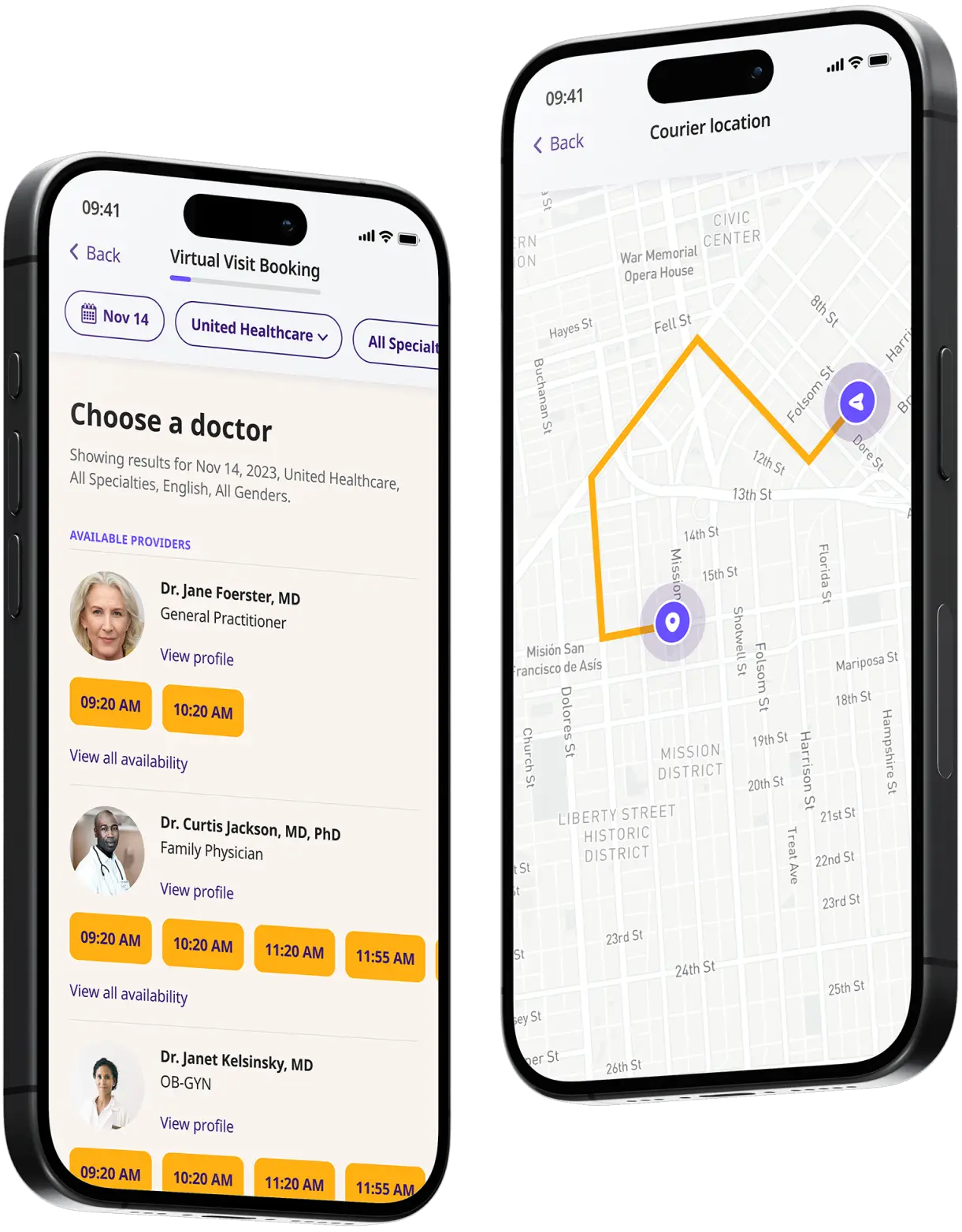Get a Prescription for Diuretics Online
Manage fluid retention & support blood pressure with ease. Our doctors are available 24/7 to prescribe diuretics online.


Available in 50 states. Insurance accepted.
Fast
virtual visits
24/7 care
assistants
Prescriptions
as needed



See If Delivery Is Available Near You
Delivery Not Available
Enter your ZIP code to check if prescription delivery is available in your area and how soon your meds could arrive.
How to get started
Choose your doctor, start a virtual visit, and have your prescriptions sent to your preferred pharmacy for pickup — all in just a few easy steps.
Choose a doctor
Choose a physician by availability, specialty, ratings, and more.

Start a video call
Get connected with a doctor anytime, anywhere.

1-Hour Rx Delivery
Your prescription delivered to your door in 1 hour or less.

Available in 50 states. Insurance accepted.
One-Time
Physician Visit
One-time visit with a physician for diagnosis, treatment, Rx, labs, referrals, and doctor’s notes.
Accepted Insurances
See why people turn to DrHouse...
As seen in

Diuretics
What are diuretics?
Diuretics, commonly referred to as water pills, are medications designed to promote urine production in the body, thereby aiding in the elimination of excess salt and water. These medications are crucial for managing various medical conditions by regulating the body’s fluid levels.
Diuretics function by stimulating the kidneys to remove more sodium and water from the bloodstream, which helps to reduce the volume of fluid flowing through the blood vessels.
This process not only helps to alleviate swelling and fluid retention but also plays a significant role in managing blood pressure levels.
There are several types of diuretics, each working at different parts of the kidneys and each suited for different therapeutic needs.
Types of diuretics
Diuretics are classified into several categories based on their mechanism of action within the kidneys and their specific uses in medical treatment. Here are the main types:
- Thiazide diuretics:
- Action: Increase the excretion of sodium and water by inhibiting the sodium-chloride symporter in the distal convoluted tubule of the kidney.
- Uses: Mainly used for hypertension and mild to moderate fluid retention.
- Loop diuretics:
- Action: Act on the ascending loop of Henle in the kidney, blocking the Na+/K+/2Cl- transporter, which leads to a significant increase in urine output.
- Uses: Effective in treating severe fluid overload conditions such as acute heart failure, chronic kidney disease, and edema.
- Potassium-sparing diuretics:
- Action: Reduce the excretion of potassium from the body, either by directly blocking sodium channels or by inhibiting aldosterone (a hormone that increases the excretion of potassium).
- Uses: Used to prevent hypokalemia in patients taking other diuretics; beneficial in conditions like heart failure where aldosterone levels are elevated.
- Carbonic anhydrase inhibitors:
- Action: Inhibit the enzyme carbonic anhydrase which is involved in the reabsorption of bicarbonate in the kidney, leading to increased bicarbonate, sodium, and water excretion.
- Uses: Primarily used to treat glaucoma, altitude sickness, and in certain cases, epileptic seizures.
- Osmotic duretics:
- Action: Work by increasing the solute load of the glomerular filtrate, which inhibits water reabsorption and increases urine output.
- Uses: Used to reduce intracranial pressure or treat acute kidney failure where rapid diuresis is required.
Each type of diuretic targets specific pathways in the kidney’s nephron, the basic structural and functional unit of the kidney, to promote diuresis—the increased production of urine. This helps manage various health conditions by controlling the volume and composition of body fluids.
Conditions treated by diuretics
Diuretics are versatile medications used in the management of several medical conditions associated with the retention of excess fluid in the body. The primary uses of diuretics include:
- High blood pressure (hypertension): Diuretics help lower blood pressure by reducing the volume of fluid in the blood vessels, which decreases the pressure on artery walls.
- Heart failure: In heart failure, the heart is less effective at pumping blood, leading to fluid buildup in the lungs and other body parts. Diuretics help remove this excess fluid, easing symptoms like swelling and shortness of breath.
- Liver cirrhosis: Cirrhosis can cause fluid to accumulate in the abdomen (ascites) and in the legs (edema). Diuretics are used to manage these symptoms by promoting the removal of excess fluid.
- Kidney disorders: Conditions like nephrotic syndrome, which is characterized by significant protein in the urine, can cause severe swelling. Diuretics help to reduce this swelling by increasing urine output.
- Pulmonary edema: This is an acute condition where fluid accumulates in the lungs, making breathing difficult. Diuretics are often used in emergency situations to rapidly remove fluid and improve breathing.
- Glaucoma: Certain types of diuretics (like carbonic anhydrase inhibitors) can help reduce the pressure inside the eye that’s typical with glaucoma.
These medications may also be used in the treatment of other conditions that involve fluid retention or require the reduction of fluid volumes in the body.
How do diuretics work?
Diuretics are a class of medications that help the body eliminate excess fluid by increasing urine production and secretion. Their primary action involves targeting various parts of the kidneys—the organs responsible for filtering blood, removing waste, and balancing body fluids and electrolytes.
Mechanism of action:
- Increase in salt excretion: Most diuretics work by blocking the reabsorption of sodium in the kidneys. Since water follows sodium, increasing salt excretion naturally leads to increased water removal from the bloodstream into the urine.
- Specific targeting in the kidneys: Different types of diuretics act on specific parts of the renal (kidney) tubule system:
- Thiazide diuretics inhibit the sodium-chloride transporter in the distal convoluted tubule.
- Loop diuretics are more potent and act on the ascending loop of Henle, inhibiting the sodium-potassium-chloride cotransporter.
- Potassium-sparing diuretics work in the distal convoluted tubule and collecting ducts, affecting the sodium channels and/or aldosterone receptor, which helps save potassium while still promoting sodium excretion.
- Volume reduction: By promoting the excretion of sodium and water, diuretics reduce the fluid volume within blood vessels, leading to a decrease in blood pressure and less strain on the cardiovascular system.
- Impact on blood pressure and swelling: The reduction in fluid volume helps lower blood pressure and reduce swelling—common issues in conditions like hypertension, heart failure, and certain kidney or liver diseases.
- Rapid action: Diuretics generally begin to work within hours of administration, offering quick relief from symptoms related to fluid buildup.
Diuretics are not only effective for managing fluid balance and blood pressure but are also crucial in treating conditions where fluid retention is a symptom, such as heart failure, kidney disorders, and certain types of glaucoma.
Common diuretics
- Thiazide diuretics:
- Hydrochlorothiazide: Often used for hypertension and mild to moderate edema. It works by reducing the reabsorption of sodium in distal tubules.
- Chlorthalidone: Similar to hydrochlorothiazide but with a longer duration and greater efficacy in lowering blood pressure.
- Indapamide: Less potent as a diuretic but frequently used for its effects on hypertension.
- Loop diuretics:
- Furosemide (Lasix): Very potent, used primarily to treat severe edema associated with heart failure, liver cirrhosis, and kidney disease. It acts on the ascending loop of Henle in the kidney.
- Bumetanide (Bumex): More potent and faster-acting than furosemide, used in similar conditions.
- Torsemide (Demadex): Has a longer duration of action compared to furosemide, useful in chronic management of heart failure.
- Potassium-sparing diuretics:
- Spironolactone (Aldactone): Used to treat fluid buildup due to heart failure, liver scarring, or kidney disease. It also helps prevent potassium levels from dropping too low.
- Triamterene (Dyrenium): Helps keep potassium in the body while still promoting water excretion, used in combination with other diuretics to enhance efficacy.
- Amiloride (Midamor): Often used in combination with a thiazide diuretic to minimize the potassium loss commonly caused by other diuretics.
- Carbonic anhydrase inhibitors:
- Acetazolamide (Diamox): Primarily used for the treatment of glaucoma to reduce intraocular pressure, also helpful in managing altitude sickness.
- Osmotic diuretics:
- Mannitol (Osmitrol): Used to decrease high pressures in the brain (intracranial pressure) or the eyes (intraocular pressure). It works by creating a high osmotic pressure in the kidneys, pulling water into the urine.
How DrHouse can help you!
DrHouse is a comprehensive telehealth service designed to provide convenient, accessible healthcare for a wide range of conditions, available 24/7 across all 50 states.
Our user-friendly app allows patients to connect with qualified healthcare professionals from the comfort of their own homes, eliminating the stress of traditional in-person visits. Whether you are experiencing symptoms related to hypertension, fluid retention, or other ailments that may require diuretics or specific medical evaluations, our platform offers the expertise you need at your fingertips.
Through DrHouse, patients can receive online consultations, tailored treatment plans, and prescriptions that are filled efficiently to ensure timely access to medications.
Our team of licensed doctors is equipped to address various health concerns making it easy to manage your health proactively. With the ability to get medical advice, online prescriptions, ask questions, and follow up on treatment plans, DrHouse ensures that your healthcare experience is not only effective but also personalized.
Don’t wait to take control of your health! Download the DrHouse app now and experience the convenience of telehealth services tailored to your needs. Connect with our licensed healthcare professionals for expert advice, personalized treatment plans, and swift prescriptions—all from the comfort of your home.
Related services
Explore more of our services tailored to your needs and discover additional ways we can support your healthcare needs.
Frequently asked questions



